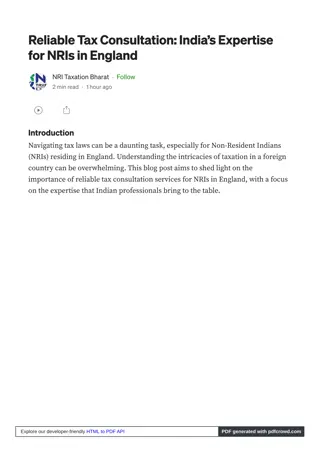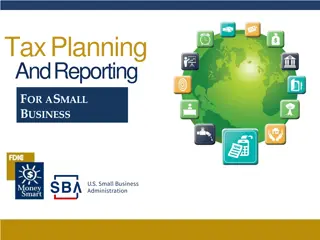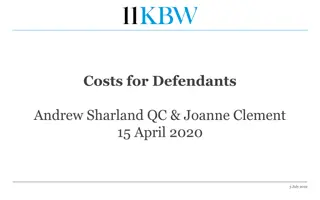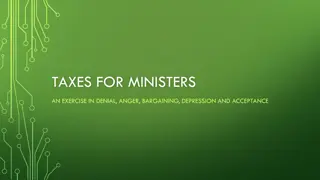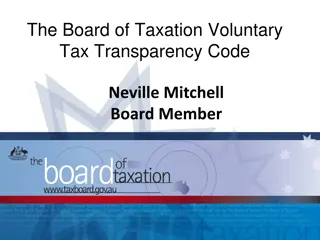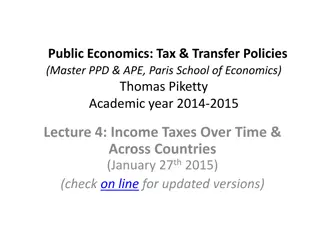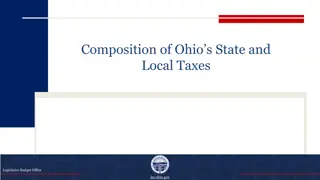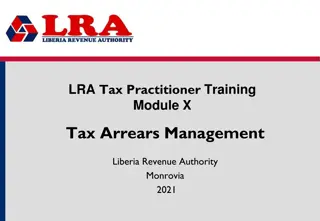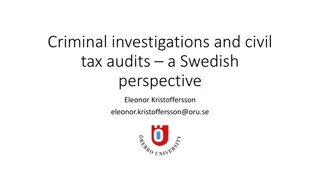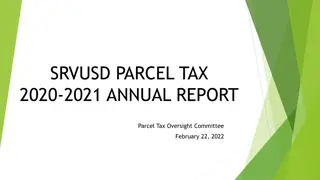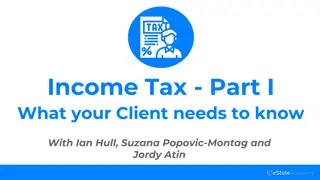Analysis of State Tax Costs on Businesses: Location Matters
Explore the comprehensive analysis of state tax costs on businesses in "Location Matters." The study reveals varying tax burdens across different states, with insights on the impact on business operations. Findings highlight the significance of location in determining corporate tax liabilities and provide valuable information for companies navigating tax environments. The presentation covers key aspects such as state and local tax burden reports, business tax climate index, and real-world comparisons of tax costs. Discover how state tax policies can influence corporate financial strategies and overall competitiveness.
Download Presentation

Please find below an Image/Link to download the presentation.
The content on the website is provided AS IS for your information and personal use only. It may not be sold, licensed, or shared on other websites without obtaining consent from the author.If you encounter any issues during the download, it is possible that the publisher has removed the file from their server.
You are allowed to download the files provided on this website for personal or commercial use, subject to the condition that they are used lawfully. All files are the property of their respective owners.
The content on the website is provided AS IS for your information and personal use only. It may not be sold, licensed, or shared on other websites without obtaining consent from the author.
E N D
Presentation Transcript
Location Matters: A Comparative Analysis of State Tax Costs on Business The Tax Foundation, in collaboration with KPMG
Presenters: Scott Hodge, President, Tax Foundation Hartley Powell, Principal, KPMG Ulrich Schmidt, Sr. Manager, Global Location and Expansion Services, KPMG Glenn Mair, Director, MMK Consulting Questions? Contact Richard Morrison, Media Manager, Tax Foundation: 202-464-5102 Morrison@taxfoundation.org
Study Findings in Brief: Paying state corporate taxes is like buying a car everyone pays a different price CarMax states tend to have the lowest tax costs for business
Location Matters Represents the most extensive comparison of real-world corporate tax costs across the 50 states ever undertaken.
Tax Foundation State and Local Tax Burden Report Measures how much a state taxes, i.e. the total tax burden Highest Burdens New Jersey 12.2% New York 12.1% Connecticut 12.0% Wisconsin 11.0% Rhode Island 10.7% Lowest Burdens 46. Wyoming 7.8% 47. Tennessee 7.6% 48. South Dakota 7.6% 49. Nevada 7.5% 50. Alaska 6.3% 1. 2. 3. 4. 5.
Tax Foundation State Business Tax Climate Index Measures how a state taxes, i.e. effects on all types of businesses Top Ranking States 1. Wyoming 2. South Dakota 3. Nevada 4. Alaska 5. Florida Bottom Ranking States 46. Rhode Island 47. Vermont 48. California 49. New York 50. New Jersey
Location Matters Answers the Bottom-Line Question: How Much Will My Company Pay in Taxes?
Seven Model Firms Seven Industries: Corporate Headquarters R&D Facility Independent Retail Store Call Center Distribution Center Capital-Intensive Manufacturing (Steel Factory) Labor-Intensive Manufacturing (Truck Factory) Two Variations of Each Firm: Mature firms older than 10 years New firms 3 years old, eligible for incentives
Mobile Corporations Selling Nationally: Mobile and competed for by states All C-corporations, not pass-throughs such as LLCs and S-corporations Firms have property & payroll in home state, while sales are in all other states in proportion to that state s GDP (except retail)
Two Cities Within Every State All 50 states & Washington, DC 99 Locations: Tier 1 Cities the major city in each state (For Corporate HQ, R&D Facility, Retail Store*) Tier 2 Cities a mid-size city (For Call Center, Distribution Center, Manufacturing*) * Providence Rhode Island serves for both locations
Calculate the Taxes that matter to business: Corporate net income taxes Gross receipts and franchise taxes Property taxes Unemployment insurance (UI) taxes Sales taxes on business equipment
And, The Most Common Tax Incentives: New jobs credit Investment credit R&D tax credit Payroll withholding tax rebates Property tax abatements
Two Measurement Tools: Total Effective Tax Rates (TETR) all state/local taxes divided by pre-tax business profits Index Scores ranks state tax burdens against the national average e.g.: National Average = 100 Score of 120 = 20% above avg. Score of 80 = 20% below avg.
3 Ways to Compare Corporate Tax Bills: Differences across 50 states a composite ranking for all 7 firm types Differences across industries within each state Differences between new firms (eligible for incentives) and mature firms (no incentives) within each state
Caveats and Limitations Tax law through April 1, 2011 Seven model firms may not represent all businesses Rankings and burdens don t necessarily reflect the quality of a state s tax system we make no value judgment here States can achieve similar results in different ways Assumptions matter
MatureFirm Composite Results Why Do They Rank Well? Lowest Tax Cost States 1. Wyoming 2. South Dakota 3. Georgia 4. Nevada 5. Ohio 6. Utah 7. North Carolina 8. Maryland 9. Nebraska 10.Louisiana No corporate income tax WY, SD, NV, (OH) Low CIT rate UT, GA Single sales factor No throwback rule Top ten index score in multiple firm types but much variation
MatureFirm Composite Results Highest Tax Cost States Why Do They Rank Poorly High tax rates not just CIT Top ten burden for at least one tax type CIT, sales, UI, property Unfavorable apportionment, sourcing rules Subject high percentage of income to state CIT Bottom ten ranking in multiple firm types 41. New Jersey 42. New York 43. Indiana 44. Massachusetts 45. Illinois 46. Rhode Island 47. Kansas 48. West Virginia 49. Hawaii 50. Pennsylvania
NewFirm Composite Results Why Do They Rank Well? Six states also top- ranked for mature firms (NE, LA, GA, OH, WY, UT) Aggressive with tax incentives (NE, LA, WI, not WY) Incentives moved AR, KY, OK to jump from middle to top Lowest Tax Cost States 1. Nebraska 2. Louisiana 3. Ohio 4. Wisconsin 5. Oklahoma 6. Georgia 7. Kentucky 8. Arkansas 9. Wyoming 10.Utah
NewFirm Composite Results Highest Tax Cost States Why Do They Rank Poorly Five states also worst for mature firms (HI, KS, MA, PA, RI) Maryland top ten for mature firms, bottom ten for new High property taxes High sales taxes on equipment & inventory Few/lack of incentives (TX, CA) 41. Iowa 42. Texas 43. Massachusetts 44. Rhode Island 45. California 46. Maryland 47. Colorado 48. Kansas 49. Pennsylvania 50. Hawaii
Industries Taxed Differently Within States Example: Minnesota (39th for Mature firms) Capital-Intensive MFG Labor-Intensive MFG Corporate HQ Distribution Center TETR 6.2% 10.0% 22.4% 45.9% Rank 7 22 47 46
Wide Variations of Effective Tax Rates Between Mature and New Firms Nebraska Call Center Mature: 20.1% New: 1.1% Louisiana Capital-Intensive MFG Mature: 10.9% New: 1.0% Arkansas R&D Facility Mature: 13.6% New: 6.7%
Corporate Headquarters Mature: Wyoming 1st Pennsylvania 50th New: Nebraska 1st Pennsylvania 50th
R&D Facility Mature: Louisiana 1st Pennsylvania 50th New: Louisiana 1st Pennsylvania 50th
Retail Store Mature: Wyoming 1st Pennsylvania 50th New: South Dakota 1st Iowa 50th
Call Center Mature: South Dakota 1st New Jersey 50th New: Nebraska 1st West Virginia 50th
Distribution Center Mature: Wyoming 1st Iowa 50th New: Ohio 1st Kansas 50th
Capital-Intensive Manufacturing Mature: Wyoming 1st Hawaii 50th New: Louisiana 1st Maryland 50th
Labor-Intensive Manufacturing Mature: Wyoming 1st Hawaii 50th New: Louisiana 1st Hawaii 50th
Take Aways There are considerable variations in average corporate tax burdens across the 50 states There are considerable variations in the tax burdens faced by different firm types within each state There are often large differences in tax burdens between mature and new firms within each state CarMax usually has the lowest price
Presenters: Scott Hodge, President, Tax Foundation Hartley Powell, Principal, KPMG Ulrich Schmidt, Sr. Manager, Global Location and Expansion Services, KPMG Glenn Mair, Director, MMK Consulting Questions? Contact Richard Morrison, Media Manager, Tax Foundation: 202-464-5102, Morrison@taxfoundation.org
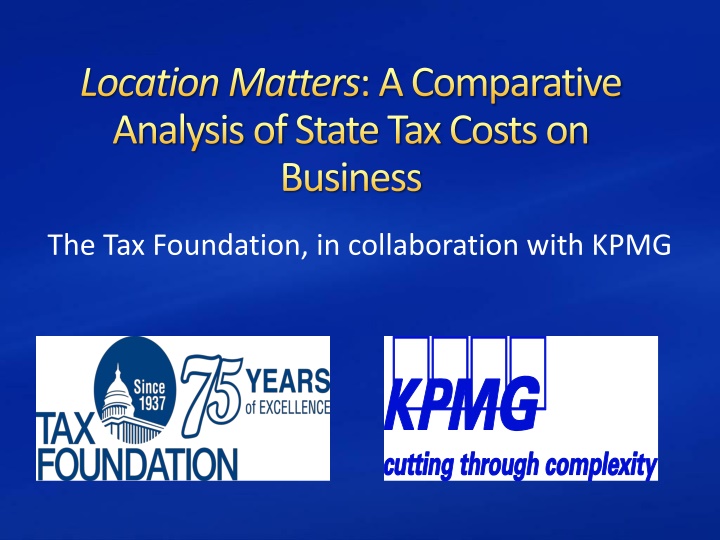


![Town of [Town Name] Real Estate Tax Rates and FY 2024 Budget Summary](/thumb/62211/town-of-town-name-real-estate-tax-rates-and-fy-2024-budget-summary.jpg)
